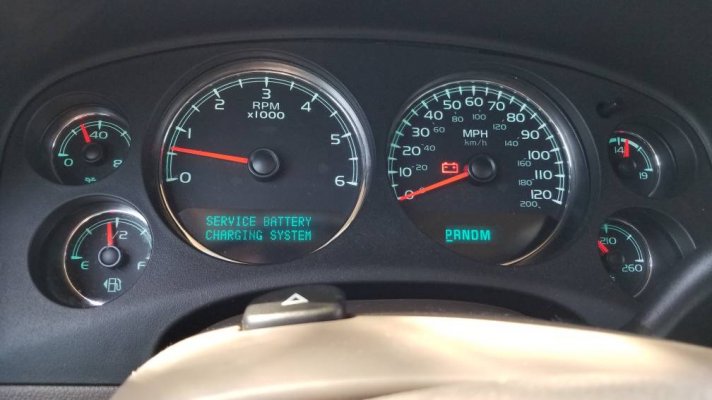The “Service Battery Charging System” warning indicates a problem with your vehicle’s charging system. This issue often involves the alternator or battery.
A properly functioning battery charging system is crucial for any vehicle. It ensures the battery remains charged and the electrical components operate smoothly. Ignoring the “Service Battery Charging System” warning can lead to a dead battery and potential vehicle breakdown.
Common causes include a faulty alternator, worn-out battery, or loose wiring connections. Addressing this issue promptly can prevent more severe problems and costly repairs. Regular maintenance and timely checks can help keep your vehicle’s charging system in optimal condition. Always consult a professional mechanic to diagnose and resolve any issues accurately.
Introduction To Service Battery Charging Systems
A Service Battery Charging System ensures that your battery remains charged. This system is crucial for the efficient functioning of various devices. It helps in maintaining the health and longevity of the battery. Understanding its components and importance can aid in better maintenance.
The Importance Of Reliable Power
Reliable power is essential for the smooth operation of devices. Without a well-functioning charging system, batteries can fail. This can lead to costly downtimes and repairs. A reliable Service Battery Charging System ensures devices run without interruption. It prevents unexpected power failures and extends battery life.
Basic Components
A Service Battery Charging System consists of several key components. Each plays a vital role in ensuring efficient charging.
| Component | Function |
|---|---|
| Battery | Stores electrical energy for future use. |
| Charger | Supplies electric current to charge the battery. |
| Control Unit | Monitors and regulates the charging process. |
| Wiring | Connects all components for seamless operation. |
Understanding these basic components can help in identifying issues. Proper maintenance of each part ensures the system works efficiently. This leads to a longer battery life and reliable power supply.

Credit: www.tahoeyukonforum.com
Types Of Battery Charging Systems
Understanding the types of battery charging systems is crucial for maintaining battery health. Different systems serve various needs. Let’s explore these systems in detail.
Traditional Lead-acid Systems
Traditional lead-acid systems are the oldest type of battery charging systems. They are commonly used in vehicles.
- These systems are cost-effective.
- They are simple to maintain.
- They have a long lifespan.
Lead-acid batteries consist of lead plates and sulfuric acid. They store energy in chemical form.
Here is a table summarizing the key features:
| Feature | Details |
|---|---|
| Cost | Low |
| Maintenance | Easy |
| Lifespan | Long |
Modern Lithium-ion Solutions
Modern lithium-ion solutions are advanced and efficient. They are used in many portable devices.
- These systems are lightweight.
- They have a high energy density.
- They offer quick charging times.
Lithium-ion batteries use lithium compounds to store energy. They are more efficient than lead-acid batteries.
Here is a table summarizing the key features:
| Feature | Details |
|---|---|
| Cost | High |
| Maintenance | Minimal |
| Lifespan | Medium |
Key Features To Look For
Choosing the right Service Battery Charging System can be overwhelming. Understanding the key features is crucial. Here, we break down the most important aspects to consider.
Charging Speed
The charging speed is vital for efficiency. A faster charging speed ensures your batteries are ready quickly. Look for systems that offer a range of speed settings. This allows you to balance between fast charging and battery longevity. Some systems provide a turbo mode. This is useful for urgent charging needs.
Compatibility With Different Batteries
A good charging system should be versatile. Ensure it is compatible with different battery types. These include lithium-ion, nickel-metal hydride, and lead-acid batteries. Compatibility means you can use the same charger for various devices. This saves you money and space.
| Battery Type | Compatibility |
|---|---|
| Lithium-ion | Yes |
| Nickel-metal hydride | Yes |
| Lead-acid | Yes |
Safety Mechanisms
Safety mechanisms are crucial in a charging system. They protect your batteries from damage. Look for features like overcharge protection and short-circuit protection. These features prevent accidents and extend battery life. An automatic shut-off feature is also beneficial. It stops charging once the battery is full.
- Overcharge protection
- Short-circuit protection
- Automatic shut-off
These features ensure your batteries are safe and last longer. Investing in a safe charging system is always a wise choice.

Credit: www.caseyschevy.com
Installing Your Charging System
Installing your service battery charging system can be straightforward. Follow these steps to ensure a safe and efficient setup. This guide will cover how to choose the right location and provide a detailed step-by-step installation guide.
Choosing The Right Location
Selecting the best location for your charging system is crucial. Ensure the area is dry, ventilated, and away from direct sunlight. Avoid places prone to dust or debris. The location should be easily accessible for maintenance.
Consider the following factors:
- Ventilation: Good airflow prevents overheating.
- Accessibility: Easy access for installation and maintenance.
- Safety: Keep away from flammable materials.
Step-by-step Installation Guide
Follow these steps to install your service battery charging system:
- Read the Manual: Familiarize yourself with the manufacturer’s instructions.
- Gather Tools: Ensure you have all necessary tools like screwdrivers, pliers, and wrenches.
- Mount the Charger: Secure the charger in the chosen location using screws or brackets.
- Connect the Wires: Attach the positive and negative wires to the corresponding terminals. Use proper wire connectors.
- Check Connections: Ensure all connections are tight and secure.
- Power On: Turn on the charging system and check for any error indicators.
If you follow these steps, your service battery charging system should be ready to use.
Maintaining Your System For Optimal Performance
Keeping your Service Battery Charging System in top shape is key. Regular maintenance ensures your battery lasts longer and works better. Follow these easy steps to keep your system running smoothly.
Regular Check-ups
Regular check-ups are essential for optimal performance. Inspect your battery and charging system at least once a month. Look for signs of wear or damage. Clean the battery terminals to ensure a good connection.
- Check battery fluid levels
- Inspect for corrosion
- Ensure tight connections
Use a voltmeter to check the battery voltage. A healthy battery should read between 12.4 and 12.7 volts. If the voltage is outside this range, it might be time to troubleshoot.
Troubleshooting Common Issues
Troubleshooting helps identify and fix problems early. Here are some common issues and solutions:
| Issue | Possible Cause | Solution |
|---|---|---|
| Battery not charging | Loose connections | Tighten all connections |
| Battery drains quickly | Faulty battery | Replace the battery |
| Corrosion on terminals | Exposure to elements | Clean with baking soda solution |
Always wear safety gear when working with batteries. If you are unsure, seek professional help. Regular maintenance and troubleshooting keep your system in top condition.
Innovations In Charging Technology
Modern charging technologies have revolutionized how we power our devices. These innovations ensure batteries charge faster and last longer. Let’s explore two groundbreaking advancements in charging systems.
Wireless Charging Systems
Wireless charging eliminates the need for cables. It uses electromagnetic fields to transfer energy. Simply place your device on a charging pad. The charging pad and receiver work through inductive coupling.
Here are the benefits of wireless charging:
- Convenience: No need to plug in cables.
- Durability: Less wear and tear on charging ports.
- Safety: Reduced risk of electric shocks.
Some popular wireless charging standards include:
| Standard | Description |
|---|---|
| Qi | Widely used for smartphones and tablets. |
| PMI | Common in public infrastructure like cafes. |
Solar-powered Options
Solar-powered charging harnesses the sun’s energy. It’s an eco-friendly alternative to traditional methods. Solar panels convert sunlight into electric energy.
Consider the following features of solar-powered chargers:
- Portability: Lightweight and easy to carry.
- Sustainability: Uses renewable energy sources.
- Independence: No need for electrical outlets.
Solar-powered chargers are ideal for outdoor activities. They are perfect for camping, hiking, and emergencies. They support various devices, including phones and tablets.
Here are some common types of solar chargers:
| Type | Features |
|---|---|
| Foldable Panels | Easy to pack and store. |
| Portable Power Banks | Store energy for later use. |
Case Studies: Success Stories
Service Battery Charging Systems have transformed energy consumption in homes and businesses. They offer reliable, efficient, and sustainable power solutions. Below are some success stories that highlight their impact.
Residential Applications
Many homeowners have switched to Service Battery Charging Systems. They have seen significant savings. One such case is the Johnson family in Texas.
| Household | Location | Monthly Savings | System Type |
|---|---|---|---|
| Johnson Family | Texas | $150 | Solar Battery |
| Smith Family | California | $180 | Wind Battery |
The Johnsons installed a solar battery system. Their electric bills dropped by $150 monthly. Their home is now more eco-friendly.
Commercial Successes
Businesses have also benefited from Service Battery Charging Systems. For instance, GreenTech Solutions in New York.
- Location: New York
- Type: Manufacturing
- Monthly Savings: $500
- System Type: Hybrid Battery
GreenTech Solutions used a hybrid battery system. They saved $500 monthly on energy costs. This system has boosted their sustainability efforts.
Another success story is Fresh Market in Florida.
- Location: Florida
- Type: Retail
- Monthly Savings: $350
- System Type: Solar Battery
Fresh Market installed a solar battery system. Their energy savings reached $350 monthly. They have reduced their carbon footprint significantly.

Credit: www.reddit.com
Future Trends In Battery Charging
The future of battery charging systems is evolving rapidly. Innovations are transforming how we charge devices. Let’s explore some exciting trends shaping this industry.
Eco-friendly Solutions
Eco-friendly solutions are gaining traction. These methods focus on reducing carbon footprints. The goal is to create a greener planet.
- Solar-powered chargers: Utilize sunlight to charge batteries.
- Wind energy: Harnesses wind to generate power.
- Bioenergy: Uses organic materials for charging.
These solutions are sustainable and cost-effective. They help in conserving natural resources.
Smart Charging Networks
Smart charging networks are the future of battery systems. These networks use advanced technology for efficient charging.
| Feature | Description |
|---|---|
| AI Integration | Artificial intelligence optimizes charging patterns. |
| IoT Connectivity | Devices connect seamlessly for better performance. |
| Remote Monitoring | Monitor battery health from a distance. |
These features enhance user experience. They also ensure longer battery life.
In summary, eco-friendly solutions and smart charging networks are leading the way. They promise a sustainable and efficient future for battery charging systems.
Frequently Asked Questions
What Is A Service Battery Charging System?
A service battery charging system ensures your vehicle’s battery is charged. It helps maintain optimal performance and prevents battery-related issues.
Why Is My Car Displaying A Service Battery Light?
A service battery light indicates a charging system problem. It could be due to a failing alternator, battery, or wiring issue.
How Do I Fix A Service Battery Charging System?
To fix a service battery charging system, check the alternator, battery, and wiring. Consult a professional mechanic if necessary.
Can A Bad Alternator Affect Battery Charging?
Yes, a bad alternator can affect battery charging. It may prevent the battery from receiving adequate charge, leading to power issues.
Conclusion
Maintaining your service battery charging system ensures optimal vehicle performance. Regular checks prevent unexpected breakdowns. Invest time in understanding your battery’s needs. A well-maintained system extends the battery’s lifespan. Stay proactive and keep your vehicle running smoothly. Your efforts today can save costly repairs tomorrow.
